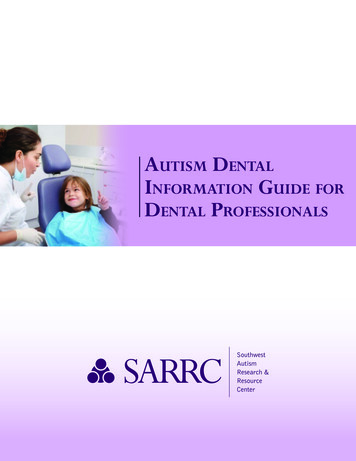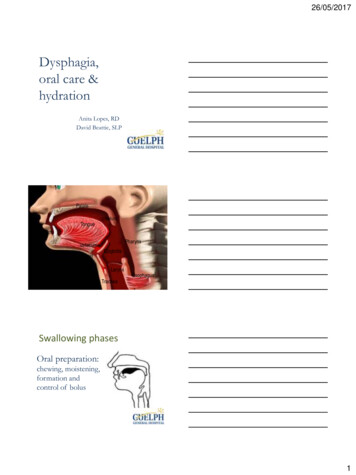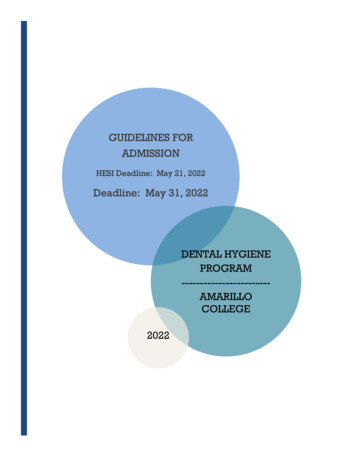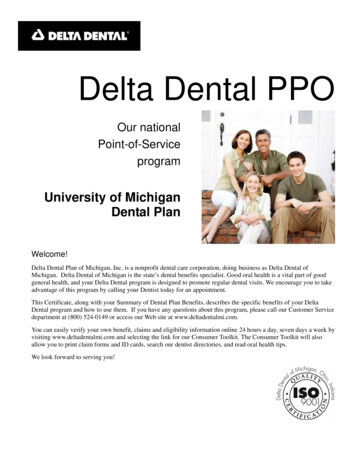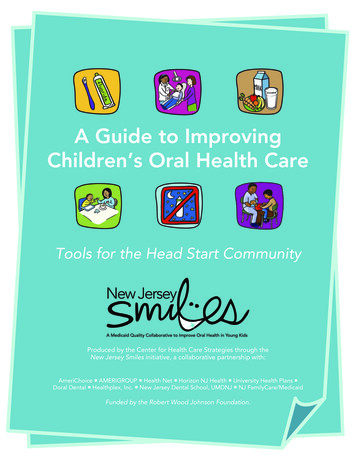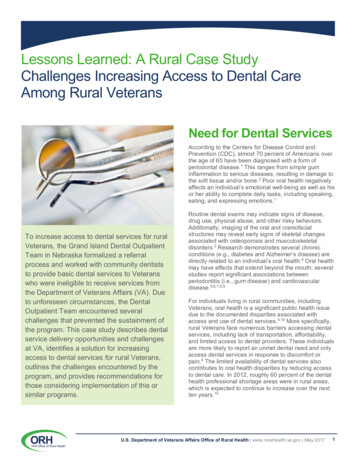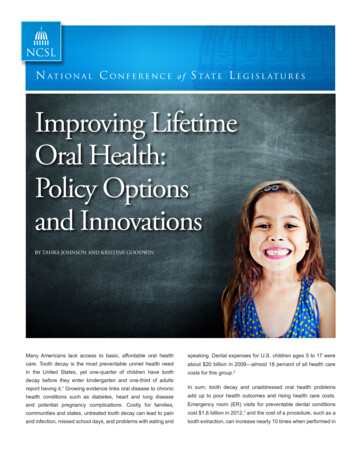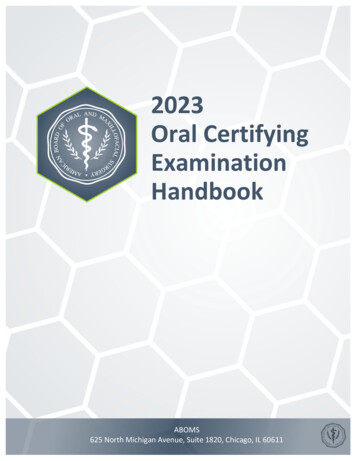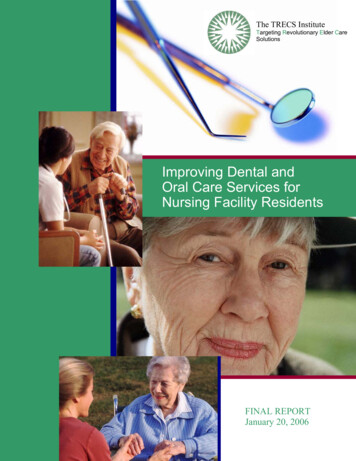
Transcription
Final ReportThe TRECS InstituteTargeting Revolutionary Elder CareSolutionsImproving Dental andOral Care Services forNursing Facility ResidentsFINAL REPORTJanuary 20, 20061
Final ReportThe TRECS Institute“Targeting Revolutionary Elder Care Solutions”Improving Dental andOral Care Servicesfor Nursing Facility ResidentsFinal ReportJanuary 20, 2005The TRECS Institute is a non-profit 501 (3) organization dedicated to serving as acatalyst to bring about positive changes and improvements to the long term care industry.For more information on The TRECS Institute, please visit www.TheTRECSInsitute.orgThe Board of Directors of The TRECS Institute identified dental and oral care for nursinghome residents as a major area of concern and targeted this topic for research. The Boardwishes to thank the State of Florida, Agency for Health Care Administration for theirgenerous support of this initiative.2
Final ReportImproving Dental and Oral Care Services for Nursing Facility ResidentsLinda A. Whitman, PhD and John Whitman, MBA, LNHAAbstractObjective:This paper discusses the findings of a recent study designed to understand how long-termcare residents in nursing homes currently receive dental and oral care services and to identifyimproved methods of assuring better dental and oral care services in the future.Methods:A research team was assembled of qualified professionals, representing a variety ofdisciplines essential to assure the success of this research project and the credibility to thefindings and recommendations developed.A literature review was conducted in the following areas: oral health assessment, oral care ofelderly in homes, institutionalized aged, nursing dental assistants, oral health in elder care,portable dentistry, aspiration pneumonia, periodontal disease, diabetes mellitus, mobiledentistry, and the Surgeon General’s Call to Action. The search was conductedthrough Medline from 1998-2004 through the library at the University of Pennsylvania’sSchool of Dentistry.In June of 2005, six focus groups were conducted in the State of Florida. Three groups withresidents of nursing homes and three groups with families of current residents. Focus groupsizes ranged from six to ten participants and were conducted by a professional focus groupleader.Interviews with other industry experts, nursing facility staff, administrative staff, geriatricdentists, general practice dentists specializing in nursing home care, geriatricians, attorneysspecializing in eldercare and healthcare issues, insurance experts, brokers and social workerswere conducted by telephone and in person.A legal and regulatory review, evaluating all applicable laws, regulations and reimbursementissues regarding the provision of oral and dental care services for nursing home residents wasconducted by an attorney specializing in eldercare and dental services for the elderly.A summit of the key members of the research team was held to review all data and developfindings and recommendations. The draft report was then circulated among the entire team aswell as a select group of industry experts for review and comment.The final report was submitted to the State of Florida, Agency for Health CareAdministration. The educational programs being developed as a result of this study andtargeted to nursing facility staff, families and residents, will be distributed to nursingfacilities throughout the State of Florida.3
Final ReportFindings:The dental and oral health care needs of the elderly residing in nursing homes are not beingadequately met due to several key factors:#1. A pervasive lack of knowledge of the importance of dental and oral health care on thepart of residents, their families and the nursing facilities staff.#2. Difficulties faced by some residents in providing self care due to physical limitationsdespite the desire to maintain good oral health and the desire to remain independent.#3. Providing good daily oral care to residents with dementia and/or behavioral problems canbe extremely difficult for staff despite good intentions and efforts.#4. Ageism prejudices are overtly evident among staff, families and even the residentsthemselves.#5. A lack of or severely limited reimbursement for professional dental services resulting insignificant access problems.#6. Extremely poor dental and oral health care is currently being seen among the cohort ofelderly between the time they retire and their admission to a nursing facility, resulting in newnursing home residents with tremendous dental and oral care needs upon admission.Conclusions:The following conclusions were generated from this study:#1. There is a profound and basic need to develop a program to educate all cohorts includingresidents, family and health care professionals on the importance of good dental and oral carefor the elderly.#2. Long-term care professionals should implement a preventive oral screening programconsisting, not only of entrance examinations but also routine (daily) preventive care, withspecial training of staff for challenging patient types.#3. A recently developed commercial dental insurance program designed specifically fornursing home residents, should be tested as a realistic approach to improving dental careservices by increasing reimbursement for dental professionals thereby eliminating the accessproblem that dominates the industry today.4
Final Report#4. The use of dental hygienists should be expanded within the nursing home setting byallowing collaborative relationships with dentists similar to the relationship nursepractitioners share with their collaborating physician in many States.#5. Taking the appropriate efforts to improve oral and dental care for nursing home residentscould have a significant impact not only on quality of life for nursing facility residents, butalso a meaningful impact on downstream medical costs for the health care system bypreventing hospitalizations and death resulting from medical care needs arising out of poororal and dental care.#6. The need for better education and preventive dentistry also needs to be stressed for thesenior population in general, especially those retiring from active employment long beforenursing home placement possibilities. Data currently shows that this population’s lack ofgood oral and dental care during the period after retirement and before entering a nursingfacility is poor at best resulting in significant dental concerns upon admission.The ultimate goal of this study was to establish an integrated approach to maintaining qualitydental and oral care for institutionalized elderly, thereby improving overall health and qualityof life for nursing facility residents while saving our health care system millions of dollars byavoiding downstream medical problems and their costs.Key Terms: ageism, oral health care,Background:The TRECS Institute (Targeting Revolutionary Elder Care Solutions) is a non-profit 501 (3)organization dedicated to serving as a catalyst to bring about positive changes andimprovements to the long term care industry.The Board of The TRECS Institute identified dental and oral care for nursing home residentsas a major area of concern and targeted this topic for a research effort. Through a generousgrant from the State of Florida, Agency for Health Care Administration, this project wasinitiated.For the purposes of this report, the terms “oral health care” or “oral dental care” will be usedand includes not only traditional dental care services, but all medical and preventativeservices that deal with the resident’s teeth, mouth and gums.5
Final ReportThe TRECS Institute and the research team associated with this project wish to thank themany organizations and professionals that contributed to the success of this effort. Specialthanks and recognition are offered to:Michael J. Helgeson, DDSChief Executive OfficerApple Tree DentalMinneapolis, MinnesotaJames E. UdanDirector of DevelopmentApple Tree DentalMinneapolis, MinnesotaBarbara Smith PH.D.Director, Geriatric Dental ProgramsUniversity of MichiganAnn Arbor, MichiganKenneth Gordon, EsquirePartner, Baker & McKenzie LLPDallas, TexasMichael Cook, EsquireEsquire, PartnerBaker & McKenzie LLPWashington, DCPatricia M. Danzon, PH.D.Director, Health Care Management ProgramThe Wharton SchoolUniversity of PennsylvaniaPhiladelphia, PA.Scott Harrington, PH.D.Professor, Health Care Systems,The Wharton SchoolUniversity of PennsylvaniaPhiladelphia, PA.Steve MosesPresidentThe Center for Long-Term Care Reform, IncSeattle, Washington6
Final ReportImproving Dental and Oral Care Services for Nursing Facility ResidentsIntroduction and HistoryThe first ever Surgeon General’s Report on Oral Health Care, published in May2000, alerted Americans that oral health care is critical to general health and well-being,and can be achieved (U.S. Department of Health and Human Services, 2000). However,profound oral health disparities exist within the U.S. population. Those who suffer theworst oral health care and hygiene include older adults residing in nursing homes.1Oral health care for elders is under-funded, under-researched, and has been a lowhealth care priority. The Surgeon General’s recent report on “Oral Health Care inAmerica” identified frail elders and nursing home residents among the populations mostvulnerable to poor dental care.2 Currently, there are approximately 34.5 million peopleage 65 and older living in America. This number is expected to increase to 70 million by2030.3 Of this 65 age cohort, 5 percent reside in over 17,000 nursing homes in the UnitedStates. An additional 16 percent of those 85 and older also reside in nursing homes.4 It hasbeen estimated that this increasing over 65 population will easily double the need for nursinghome care in this nation in the foreseeable future. As the Secretary of Health and HumanServices notes, “Ignoring oral health problems can lead to needless pain and suffering,causing devastating complications to an individual’s well being, with financial and socialcosts that significantly diminish quality of life and burden American society.” 51Coleman, P. (2002). Improving oral health care for the frail elderly: A review of widespread problems andbest practices. Geriatric Nursing, 23, 189-199.2Oral Health in America: A Report of the Surgeon General, National Institute of Dental and CraniofacialResearch, National Institutes of Health, Bethesda, MD. Online, Available n on Aging. Profile of Older Americans: 2000.4Strayer M. Consensus Conference on practical guidelines for institutionalized older dental patients. Spec. CareDent, 16:141-2, 1996.7
Final ReportYet the changing needs of elders have not been recognized in the overall healthcare plan for this special cohort. In the 1960’s, when most of our current health care policieswere being developed, the majority of elders did not have natural teeth; dental care for elderswas synonymous with denture care.6 Today, not only are people living longer, they areretaining the majority of their natural teeth. With the retention of natural teeth, dentalcare and maintenance becomes more complex and the neglect of dental care can lead toincreased health risks.7 8Oral needs of institutionalized elderly represent a special challenge. The numberof elderly and the amount of elder dental disease is increasing in the United States. Theelderly population over 65 years old is expected to double over the next twenty-fiveyears9 10 so that by 2030, twenty five percent of Americans(about 70 million) will besixty five years of age or older. Between 1960 and 1994, the population of the “oldestold,” (those above age eighty-five) increased by two hundred and seventy-fourpercent.11 12Since elders are retaining their natural teeth, their risk of oral disease increasesand it increases even more rapidly among elders unable to adequately perform their daily5. Aging America Poses Unprecedented Challenges, Says New Census, Aging Institute Report, Available atwww.nih.gov/nia/new/press/census.htm6Burt BA, Influences for change in the dental health status of populations: an historical perspective, Journal ofPublic Health Dentistry, 38(4):272-88(1978 Fall).7Ettinger RL, The unique oral needs of an aging population, Dental Clinics of North America 41(4):633-49(1997 Oct).8Berkey D., Berg R, Geriatric Oral Health Issues in the United States, International Dental Journal 51(3Suppl):254-64 (2001 Jun).9Slavkin, HC, Maturity and oral health: live longer and better, Journal of American Dental Association,131(6):805-8 (2000 Jun).10NIA News Release, Aging America Poses Unprecedented Challenge, www.nia.nih.gov/news/pr/1996/0520.htm(May, 1999).11National Center for Health Statistics , US Department of Health and Human Services. Changing MortalityPatterns. Health Services utilization and health care expenditures: US 1978-2003, analytical andepidemiological studies series 3, 1993;23(PHS PUB):83-1407.12See n. 118
Final Reportoral hygiene care. However, even for elders without teeth, the risk for oral disease isincreased. The incidence of oral mucosal diseases increases with the presence of chronicdiseases and use of multiple medications.13 Oral disease can complicate certain medicalproblems and many medical problems can increase risk of oral disease.14 Additionally,elders are prescribed an ever-expanding variety of medications; over 80 percent of whichare known to have adverse oral tissue side effects.15 Oral soft tissue lesions are estimatedto annually affect 10-38 percent of elders 65 and older, with the highest rate among frailand institutionalized elders.Dental disease rates actually begin to increase after age 45 and nearly double byage 65. Since elders are retaining their teeth, their risk of dental disease continuesthroughout their life. Aging alters the immune system response which coupled withcommon chronic conditions and medications, results in a growing population withgrowing rates of disease and a growing level of need.Exclusion of oral health from general health issues and from coverage inMedicare compounds the problem.16 17 Dental professionals suggest that dentistry’sevolution from the focal infection theory and exodontias (extraction of teeth) to today’sadvanced restorative and preventative care has created a new need for oral care amongthe current and future elderly dental consumers.1813Beck, JD., Watkins, C., Epidemiology of non-dental oral disease in the elderly, [Review] Clinics in GeriatricMedicine 8(3):447-59 (1992 Aug).14Burt BA, Epidemiology of dental diseases in the elderly, [Review] Clinics in Geriatric Medicine, 8(3):447-59(1992 Aug).15Lewis IK, Hanlon JT, Hobbins MJ, Beck JD, Use of medications with potential oral adverse drug reactionsin community-dwelling elderly, Special Care in Dentistry. 13(4):171-6 (1993 Jul-Aug).16Meskin LH, Dillenberg J, Heft MW, Katz RV, Martens LV, Economic impact of dental services utilization byolder adults, Journal of the American Dental Association 120(6):665-8(1990 Jun).17White BA., An overview of oral health status, resources and care delivery, [Review] Journal of DentalEducation 58(4):285-90 (1994 Apr).9
Final ReportThe 2000 Surgeon General’s report findings was the catalyst for the current call toaction of policymakers, community leaders, industry, health professionals and the public.Under the leadership of the Office of the Surgeon General, a National Call to Action wasestablished in the spring of 2005.According to the data collected at the Call to Action, the following elderly factswere extrapolated. Twenty-three percent of 65 to 74 year old have severe periodontal disease.Thirty percent of adults 65 years and older are edentulous.Individuals in long-term care facilities are prescribed an average of eightdrugs. Many of theses drugs have side effects such as dry mouth. Thedecrease in saliva increases the risk of oral disease.Five percent of Americans aged 65 (approximately 1.65 million) are living ina long-term care facility where dental care is problematic.Many elderly lose dental insurance with retirement. Medicare does notreimburse for dental care and Medicaid funds only for low income anddisabled in a few states and reimbursement amounts are low.(U.S. Department of Health and Human Services. Oral Health in America:A Report of the Surgeon General. Rockville, MD)Oral care in the United States is provided predominantly by dental professionalsin private practice. People who are able to 1) recognize the need for care; 2) identify aprovider; 3) obtain transportation to the provider or convince the provider to come to thefacility, and 4) pay for needed care, can enjoy the highest level of oral health care in theworld. According to dental access studies, inabilities by many elderly, especially nursinghome residents, to meet these four factors are among the most prevalent reported barriers todental care. Data from the U.S. Department of Health and Human Services states thata lack of dental insurance, private or public is one of several impediments to obtaining oralhealth care.18Ettinger, RL. Watkins, C. Cowen, H., Reflections on changes in geriatric dentistry, Journal of DentalEducation 64(10):715-22 (2000 Oct.).10
Final ReportThis paper will focus on LTC residents in nursing homes because they are theones who are the most incapacitated and for whom dental care is often only marginallyavailable. Once an individual enters a nursing home, their access to adequate dental caredrops markedly. Estimates of the percentage of these patients with unmet dental needs rangefrom 80% to 96%.19 20 This problem is likely to worsen when the baby-boom generationreaches the age when a substantial number will require LTC in a nursing home.Studies during the past decade have identified specific statistics concerning nursing facilityresidents that are concerning in general but especially from a dental care perspective: Women outnumbered men by approximately 3:121The typical resident needed help with four activities of daily living (ADLs), which arebathing, dressing, eating, toileting, and transferring-as from a bed to a chair.22Two thirds relied on Medicaid to pay for their care236% were confined to bed2480% took six or more medications daily25Up to 78% had untreated caries26More than 40% had periodontal disease27Up to three quarters of those over 65 had lost some or all teeth28More than half of those over age 75 were edentulous2980% of those who had lost all teeth had dentures, but 18% did not use them.3019Kambhu PP, Warren JJ, Hand JS, et al. Dental treatment outcomes among dentate nursing facility residents:an initial study. Spec Care Dent. 1998;18:128-132.20Warren JJ, Kambhu PP, Hand JS,. Factors related to acceptance of dental treatment services in a nursinghome population. Spec Care Dent. 1994;14;15-20.21National Nursing Home Survey 1999. Selected characteristics of homes, beds and residents. Table 3. Divisionof Data Services, National Center for Health Statistics, Centers for Disease Control and Prevention, U.S.Department of Health and Human Services. ftp.cdc.gov/pub.Health Statistics/NCHS/Datasets/nnhs/nnhs99/.22Facts and Trends: The Nursing Facility Sourcebook 2001. American Health Care Association. 2001.www.ahca.org/research/nfs/nfs2001.pdf.23The looming crisis: 15 key questions about long term care. American Health Care Association. 1998.www.ahca.org/secure/top15.htm.24see n. 2025Council on Access, Prevention and Interprofessional Relations. Providing Dental Care in Long-term CareFacilities: A Resource Manual. Chicago, IL: American Dental Association; 1997.26See n. 2327Vargas CM, Kramarow EA, Yellowitz JA. The Oral Health of Older Americans. Aging Trends; No. 3.Hyattsville, MD: National Center for Health Statistics; 2001.28see n. 2329see n. 2530see n. 2311
Final ReportThe oral health of the growing elder population in long-term care facilitiesis becoming an important social issue. Over the past several decades, the pattern of oraldisease has been shifting. Older adults in the United States are retaining their teethlonger with a significant decline in the rate of edentulism.31 32 In the New EnglandElders Dental Study (NEEDS), Douglass et al33 reported a significant decline inedentulism from 1962 to 1990 among elders age 70 and over. The number of retainedteeth per person has increased. Consequently, increased tooth survival has resulted inan increase in teeth exposed to the risk of dental disease. The NEEDS findings reveal ahigh prevalence of root caries in New England elders, suggesting a greater need fordental care than for previous generations of elders. The increasing number of olderpeople living in nursing homes at some point in their lives, combined with decliningtooth loss among the elderly, will lead to increased need for dental services within longterm care facilities.The U.S. Surgeon General’s report Oral Health in America emphasizes theimportance of oral health care to overall general health. The report describes theexisting disparities in access to dental services among different population groups,especially the very young and very old. Berkey et al.34 reviewed the oral health statusof elderly nursing home residents and reported that 70 percent of residents had unmetoral health needs. The residents exhibited high rates of dental caries, edentulism, poororal hygiene, periodontal disease, and soft tissue lesions. Unfortunately, there are31Weintraub J, Burt B. Oral health status in the United States: tooth loss and edentulism. J Dent Educ 1985;49:368-76.32Douglass CW, Jette AM, Fox CH, Tennstedt SL, Joshi A, Feldman HA, McGuire SM, McKinlay JB. Oralhealth status of the elderly in New England. J Geront 1993;48:M39-M46.33See n. 3234Berkey DB, Berg RG, Ettinger RL, Meskin LH. Research review of oral health status and service use amonginstitutionalized older adults in the United States and Canada. Spec Care Dentist 1991;11:131-6.12
Final Reportobstacles in improving and maintaining good oral health for those individuals.Many elderly Americans lack the financial resources to access dental care. Uponretirement, few older adults retain dental insurance. Kington at al.35 found that only 13percent of elder Americans have private dental insurance. Findings from the 1989National Health Interview Survey conducted by Bloom at al.36 reports significantlyhigher utilization of dental services by those elders with private dental insurance thanthose without.Barbara Smith, PhD completed her doctoral thesis in 2002 for the University ofMichigan looking at “Stability of Oral Health Status in a Long-Term Care Population – ALongitudinal Analysis of Dental Treatment Needs.” Her study focused on recordsmaintained for almost 20 years from Apple Tree Dental, a non profit organization locatedin Minneapolis, Minnesota and serving the residents of approximately 80 nursing homesin that area. What is unique about the population of nursing home residents served byApple Tree Dental is that this organization, with its non-profit mission, has literally brokenthe reimbursement barrier and its residents receive regular dental screenings, cleanings andcare, unlike other nursing home residents across the nation. By breaking the reimbursementbarrier, this unique organization is able to hire and reimburse its professional staff in amanner that makes working with nursing home residents an economically sound businessmodel. Apple Tree Dental is only able to do this because of the outside funding it isable to raise as a non profit organization that helps supplement the program’s basic35Kington R, Rogowski J, Lillard L. Dental Expenditures and insurance coverage among older adults.Gerondontol 1995;35:463-43.36Bloom B, Gift HC, Jack SS. Dental services and oral health care: United States, 1989. National Center forHealth Statistics Health Survey, Vital Health Statistics Series 10, No. 183. Hyattsville, MD: Public HealthService; 1992.13
Final Reportoperation. These findings strongly suggest that a private or commercial dental insuranceprogram that would essentially eliminate the reimbursement barrier currently in place andeffectively make the business of providing professional dental care to nursing homeresidents a financially sound model, could have a profound impact on the industry.Another very interesting finding from Dr. Smith’s work is the confirmation that alarge percentage of elderly take very poor care of their oral health needs between the timethey retire and the point at which nursing home placement becomes a reality. As a result,Dr. Smith found that the average nursing home resident, if seen by a dentist uponadmission, requires an average of 13.2 initial dental treatments with a mean ranging from2 to 66! Furthermore, after three visits and with regular and consistent oral care, theongoing need for professional care stabilized and was dramatically reduced.Oral health is integral to an older adult’s general health and quality of life, andbasic oral health services are an essential component of primary health care.37Though not usually life threatening or seriously impairing for the majority ofpeople, unchecked oral diseases in an older person can have far greater systemicimpact than in a younger individual. A common route of systemic infection by oralmicro-organisms is through the aspiration of oropharyngeal fluids containing oralpathogenic micro-organisms, which can cause pneumonia in patients with diminishedhost defenses.38 A link has been shown between dental disease and coronary heartdisease.39 Dental infections have also been shown to be a risk factor for37Dolan T, Atchison K. Implications of access, utilization and need for oral health care by the noninstitutionalized and institutionalized elderly on the dental delivery system. J Dent Educ 57:876-87, 1993.38Limeback H. Implications of oral infections on systemic diseases in the institutionalized elderly with a specialfocus on pneumonia. Ann Periodontol 3:262-75,1998.39Loesche WJ, Schork A, Terpenning MS, et al. Assessing the relationship between dental disease andcoronary heart disease in the elderly U.S. veterans. J Am Dent Assoc 129:301-11,1998.14
Final Reportarteriosclerosis.40 Some other dire consequences reported for the elderly are nutritionalcompromise, empyema, bacteremia, and brain abscess.41 As well as placing residentsat risk for life threatening conditions, oral health problems also affect self-esteem, theability to maintain a favorable self-image, and the ability to masticate food comfortablyand efficiently(which may adversely affect nutritional status).42 Oral health problemscan hamper one’s ability to live without pain or discomfort. Above all, oral health iscrucial to an individual’s quality of life.43 It is tragic that people whose quality of life isalready diminished due to cognitive and functional loss may also be sufferingunnecessarily from untreated oral disease.44 Nursing home elderly, perhaps more thanany other nursing home population group, need complete, comprehensive, and routinedental services to maintain an adequate level of oral health.45The changing demographics, barriers to treatment including apathy/ignorance,lack of perceived need, access, staff knowledge, institutional constraints,reimbursement difficulties, dentists’ lack of geriatric dental care knowledge and thedifficulty of treating elderly with functional impairment make this a unique challenge.These aging Americans deserve the opportunity to age gracefully and with dignity.They should maintain their teeth for a lifetime with manageable oral health care, andminimal functional problems that allow for a positive appearance, articulation andfunctionality. Above all, the senior citizens should have the oral care they need to pursue40Meurman JH. Dental infections and general health. Quintessence Int 28:807-11, 1997.Shay K. Dental management considerations for institutionalized geriatric patients. J Prosthet Dent 72:510-6,1994.42Kayser-Jones J, Bird W, Redford M, et al. Strategies for conducting dental examinations among cognitivelyimpaired nursing home residents. Spec Care Dent 16:46-52, 1996.43See n. 3744See n. 4245Henry R, Ceridan B. Delivering dental care to nursing home and homebound patients. Dent Clin North Am38:537-51, 1994.4115
Final Reportthe quality of life they deserve. To quote Senator John Breaux (D-LA)“Poor oral health care causes millions of vulnerable seniorsto suffer needlessly. Too often, dental problems in this populationare underestimated, ignored or not detected until far too late, resultingin serious disease and even death!”Quoted by Senator John Breaux (D-LA), ranking member of the Senate Aging Committee, In Nothingto Smile About on Older American’s Oral Health Report Card” Senate Aging Committee ExaminesAgeism in Dental Care, September 22, 2003.Study:Methodology:Phase One: Research TeamTo complete this project in the most effective way possible, a research team wasestablished comprised of industry experts in a variety of areas essential to assure ameaningful project design and accurate and reliable results. These experts included thefollowing:Yolanda Ann Slaughter, DDS, MPH,Geriatric DentistryUniversity of PennsylvaniaSchool of Dental MedicineJohn D. Cacciamani, MD, MBAGeriatric MedicineMedical Director Clinical InformaticsTemple University Health SystemDr. Erika Matulich, PhD, PCMFocus Group LeaderThe University of TampaLinda Whitman Ph.D.Research DesignMCG ServicesNorth Wales, PAJack Rosenkranz, EsqLegal and Reimbursement ReviewRosenkranz Financial ServicesTampa, Florida16
Final ReportCharlotte Albano R.N.Nursing Home ConsultantPresident, The TRECS Institute & Vice President of Clinical and Regulatory Compliance,Tandem Health CareMaitland, FloridaCynthia L. Pearse, LCSW, NHA, LHRM\EducationSocial Work Consultants of FloridaTampa, FloridaJohn Whitman MBA, NHAProject CoordinatorExecutive DirectorTRECS InstituteNorth Wales, PA.Phase Two: Literature Revie
The ultimate goal of this study was to establish an integrated approach to maintaining quality dental and oral care for institutionalized elderly, thereby improving overall health and quality of life for nursing facility residents while saving our health care system millions of dollars by avoiding downstream medical problems and their costs.



